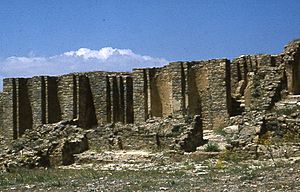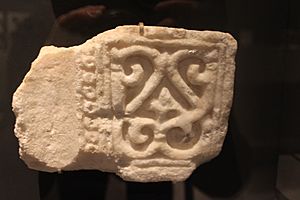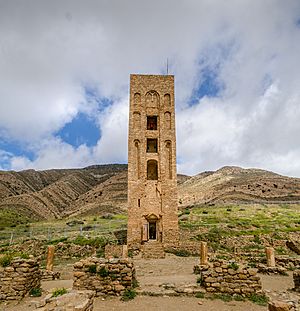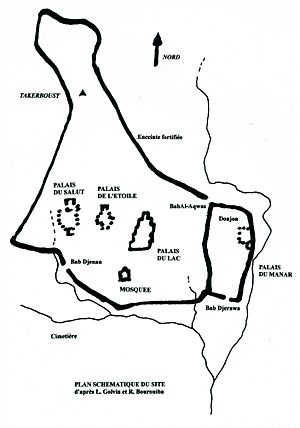Qal'at Bani Hammad facts for kids
|
قلعة بني حماد
|
|
 |
|
| Location | M'Sila Province, Algeria |
|---|---|
| Coordinates | 35°48′50″N 04°47′36″E / 35.81389°N 4.79333°E |
| Type | Settlement |
| History | |
| Builder | Hammad ibn Buluggin |
| Founded | 1007 |
| Abandoned | 1090 |
| Periods | Hammadid dynasty |
| Site notes | |
| Condition | In ruins |
| Official name | Al Qal'a of Beni Hammad |
| Type | Cultural |
| Criteria | iii |
| Designated | 1980 (4th session) |
| Reference no. | 102 |
| Region | Arab States |
Qal'at Bani Hammad (Arabic: قلعة بني حماد) was once a strong, walled city in Algeria. In the 11th century, it was the first capital city for the Hammadid dynasty. Today, it lies in ruins.
This ancient city is found in the Hodna Mountains, northeast of M'Sila. It sits high up, about 1,418 meters (4,652 feet) above sea level. The mountains around it provide plenty of water. The site is close to the town of Maadid, about 225 kilometers (140 miles) southeast of Algiers.
In 1980, UNESCO named it a World Heritage Site. They called it "Al Qal'a of Beni Hammad." UNESCO described it as a true picture of a strong Muslim city from that time.
The city had walls that stretched for about 7 kilometers (4.3 miles). Inside these walls were four living areas. It also had the biggest mosque built in Algeria after the one in Mansurah. This mosque looked a lot like the Grand Mosque of Kairouan. It had a tall minaret, which is a tower where calls to prayer are made, standing 20 meters (66 feet) high.
Digs at the site have uncovered many interesting items. These include terracotta, jewelry, old coins, and pottery. These finds show how advanced the Hammadid dynasty was. They also found decorative fountains shaped like lions. The remains of the ruler's palace, called Dar al-Bahr, had three separate homes. These homes were separated by beautiful gardens and small buildings called pavilions.
Contents
History of Qal'at Bani Hammad
The fortress was built in the year 1007. It was built by Hammad ibn Buluggin. He was the son of Buluggin ibn Ziri and the person who founded Algiers. The city became the main capital for the Hammadid Berbers.
In 1017, the city was attacked by the Zirids, but it survived. Later, in 1090, the people left the city because of a threat from the Banu Hilal. In 1152, parts of it were destroyed by the Almohads.
In the 11th century, a writer named Al-Bakri described Qal'at Bani Hammad. He said it was a very strong military base. It was also a busy trading center. Caravans from all over the Maghreb, Iraq, Syria, Egypt, and Hejaz came here. Another writer, Ibn Khaldun, noted that many travelers came. This was because the city offered a lot for people interested in science, trade, and art. Poets, wise people, and religious scholars were drawn to Qal'at Bani Hammad. The Hammadid style of building even influenced the Normans.
Archaeological digs started in 1908. They continued from 1952 to 1956 and are still happening today. Most of the site has not been explored yet. Many parts of the palaces still need to be studied more.
Architecture and Design
Exploring the Palaces
The Hammadid rulers built five palaces. Most of these palaces are now destroyed. However, the main tower of the Palace of the Fanal (Qasr al-Manar) still stands. The "Upper Palace" had three buildings. These were built around a courtyard with an unusual shape. It included a private living area, a hall with a dome, and an entrance building.
Other palaces were also built, like the Qasr al-Kawab and Qasr al-Salam. The Qasr al-Salam was likely where the ruler's family lived. This building shows many features of typical Hammadid architecture. The Qasr al-Manar is another palace. Its design is similar to the Upper Palace and Qasr al-Salam. Its main parts include a courtyard with a meeting hall and a private apartment. Both were surrounded by porticos (covered walkways) shaped like a "T".
Dar al-Bahr: The Lake Palace
The Dar al-Bahr palace was near the main mosque. It was probably used for public meetings or as the ruler's palace. Its name, "Dar al-Bahr" (House of the Lake), came from a large water pool in its eastern courtyard. The main reception room was between two courtyards. A domed hall was located north of the water court.
The outer walls of the palace had different types of supports. The water courtyard was 71 meters (233 feet) long and 51 meters (167 feet) wide. The pool itself was 68 meters (223 feet) long, 48 meters (157 feet) wide, and 1.3 meters (4.3 feet) deep. Covered walkways surrounded the courtyard on all sides.
The Dar al-Bahr palace was famous for its large rectangular pool. This pool measured 67 by 47 meters (220 by 154 feet). A ramp at one end of the pool was used to launch boats. Visitors from that time wrote about boat shows in this pool. The pool had a covered walkway around it. You could enter it through a grand entrance on the east side. West of the pool was a raised area and a courtyard with gardens. Outside the palace walls, gardens stretched across the city. They went for almost 100 meters (328 feet) deep. Archaeologists have not yet explored these gardens. However, they have found decorative fountains there.
The Great Mosque
The Hammadid mosque is thought to have been the largest mosque built in North Africa before the 20th century. It has a typical square minaret, common in the Maghreb region. In Qal'at Bani Hammad, the minaret is 25 meters (82 feet) tall. It is the only part of the Great Mosque that still stands. This minaret looks a bit like the Giralda in Seville, Spain.
Beautiful Decorations

The buildings in Qal'at Bani Hammad were beautifully decorated. They used "porcelain mosaics made of colorful faience (glazed pottery)." They also had carved panels and plaster. There were also glazed terra-cotta "stalactites," which are special hanging decorations. The buildings and pottery had geometric patterns and stylized flower designs.
Fragments of stucco were found in the Qasr al-Salam and Qasr al-Manar palaces. These might be the oldest pieces of muqarnas (a type of decorative vaulting) in the Western Islamic world. They date back to the 11th or 12th century. Some experts believe these are the oldest true muqarnas vaults found in the Islamic world.
The buildings of Qal'at Bani Hammad are also important. They show early examples of art styles that became popular later. For example, plaster capitals (the top parts of columns) found here had smooth leaves. These leaves curved back at the top. This style is seen later in buildings from the Almoravid and Almohad periods. Examples include the Great Mosque of Tlemcen.
Also, a marble basin and a gray marble piece show the use of arches with many foils (leaf-like shapes). These arches had spiral decorations. This design later spread during the Almoravid times. It became very common in Almohad buildings. The square rooms with curved ceilings in the Qasr al-Manar are similar to later Almohad minarets. The Hammadid palaces may also have some of the earliest examples of shadirwan, which are water features.
See also
 In Spanish: Al-Qal'a de Beni Hammad para niños History of medieval Arabic and Western European domes
In Spanish: Al-Qal'a de Beni Hammad para niños History of medieval Arabic and Western European domes





